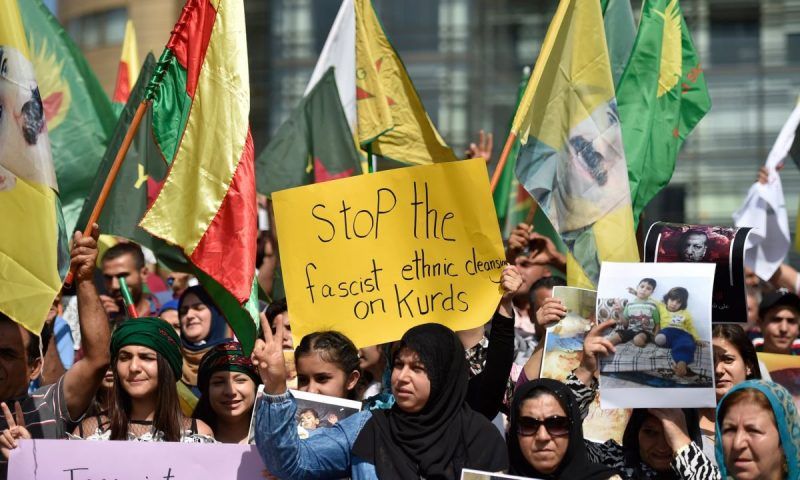
Future historians might remember Turkey’s incursion into northern Syria, launched last week, as the second time that President Recep Tayyip Erdoğan provided Islamic State with a lifeline, intentionally or not. The first was when Turkey opened its borders to foreign jihadists entering Syria, which ultimately enabled Isis to build a caliphate the size of Britain in 2014.
Both the time and manner of the intervention risk unravelling the situation in Syria beyond the buffer zone that Turkey intends to establish in the north-east. It will take the pressure off extremist forces and disturb a delicate equilibrium and the relative quiet that have existed in the country for about two years.
The move comes at a critical time in the fight against Isis, merely seven months after the collapse of the caliphate and while stabilisation and recovery are still in their early stages. In recent months, the US has stepped up efforts to improve local forces’ capabilities in detecting and removing sleeper cells linked to Isis and, under these circumstances, the group seemed to have been struggling to mount a large-scale insurgency.
President Donald Trump’s decision – allowing Ankara to invade areas previously protected by the US and controlled by a Kurdish-dominated coalition known as the Syrian Democratic Forces (SDF) – took almost everyone involved in the Syrian conflict by surprise; the Wall Street Journal reported that a commander of the Kurdish force that spearheaded the fight against Isis stormed out of a meeting with the Americans after declaring: “You sold us!”
The Kurdish-dominated local forces still needed to learn how to deal with an underground insurgency that Isis and its previous incarnations so perfected in the years after the US invasion of Iraq. The counter-insurgency efforts proved different from and, at times, more challenging than the street-to-street fighting that the SDF conducted over the past five years.
The military intervention in northern Syria disrupts this process and distracts militia in charge of securing the former Isis areas that make up one-third of the country. Despite flaws, the Kurdish-led local forces chased down Isis from town to town and village to village. This operation involved a complex effort of collecting information and intelligence. These forces learned a great deal about how Isis operates and established counter-measures and a communication mechanism for reaching out to local tribes.
The change of hands in the north alone will probably leave gaps for Isis to exploit. A similar scenario took place in Iraq, after government forces with militias beholden to Iran seized Kirkuk from the Kurdish peshmerga this time two years ago. The patterns after that were indisputable: Isis found an opportunity to stage a prolonged insurgency in that area, which expanded to adjacent areas. The attack on Kirkuk was one of many factors that enabled Isis to recover relatively faster in Iraq than in Syria. Kirkuk provided an opening and Isis seized it.
The same is likely to happen in north-eastern Syria, no matter how capable the Turkish-backed forces prove. The mere disruption of an established security architecture opens cracks for an extremist group that watches diligently for chances to regroup and attack. Once such attacks become steady, they spread to other areas. Making this scenario even more likely is the nature of Trump’s decision to allow Turkey to proceed, made impulsively, without deliberation and consultation with his team, much less with US allies on the ground.
Also, Ankara does not seem to have an endgame in mind. From a Turkish perspective, the destruction of a nascent Kurdish statelet to the south of its borders, established by a group that it views as an extension of the PKK, the separatist insurgents that it battled for four decades, has always been a top national security priority. The invasion is informed by this national priority, regardless of the costs. But beyond that calculation, Turkey has no exit strategy. In fact, the absence of an endgame by both the US and Turkey increases the risks for a security vacuum, the re-emergence of extremists and renewed chaos.
Another factor to consider is that Turkey also received a clearance from Russia before intervention, framed by Russia as part of the agreement between Ankara, Moscow and Tehran about the Syrian conflict. According to a well-placed Syrian source, the intervention in the Kurdish areas was part of a Russian-Turkish understanding about the fate of Idlib in the north-west, the last stronghold of the rebels fighting the regime of Bashar al-Assad.
Idlib is dominated by the group formerly known as Jabhat al-Nusra and various stakeholders in the Syrian conflict have struggled to agree on how to deal with the challenge of having jihadists in charge of a significant swath of the country. The source claims that Turkey also reassured the Americans that the intervention would be followed by serious steps to deal with the dilemma in Idlib, by enabling a Russia-led incursion and that any expected mass displacement from Idlib will move to the Turkish zones inside Syria, not to Turkey itself.
Until now, Turkey and the US have asserted control over two separate zones in eastern and northern Syria. In both zones, extremists pose a serious lingering challenge if the situation spins out of control. The Turkish intervention could provide this trigger in both zones concurrently.
Unless the US and western powers move to prevent such a disruptive and unpredictable scenario, the Turkish move will probably unleash the spectre of both the reheating of Syrian civil war and a resurgence in the threat of jihadist extremists, long thought to have been put under control.
Hassan Hassan is co-author of New York Times bestseller ISIS: Inside the Army of Terror, and a resident fellow at the Tahrir Institute for Middle East Policy.
